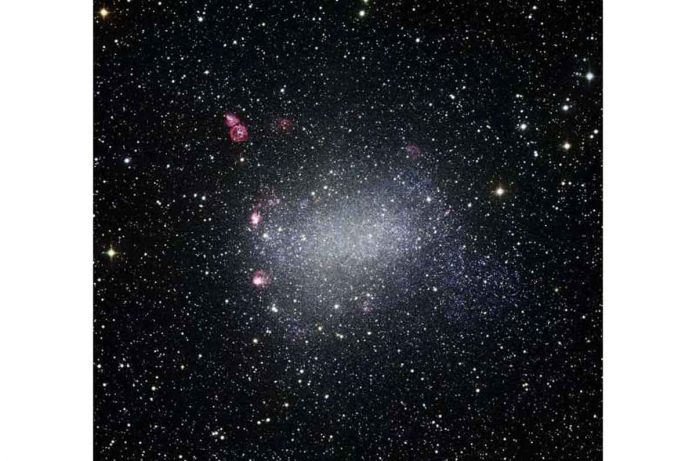A worldwide team of astronomers used the Subaru telescope to make deep multi-band photometric studies of NGC 6822, a dwarf irregular galaxy. The findings of the observational effort, which were published on arXiv.org on May 30, provide significant information on the galaxy’s star populations. NGC 6822 (also known as Barnard’s Galaxy) is a dwarf irregular galaxy in the Local Group that is 1.63 million light-years away. It is one of the Milky Way’s closest companion galaxies, but it resides barely outside its virial radius. The galaxy has a diameter of roughly 7,000 light-years and a spatially widespread structure of globular clusters (GCs).
NGC 6822 is a great observational target because of its location in the sky, which allows it to be seen from both the northern and southern hemispheres. Its short distance enables for a wide range of multi-band research, from optical through near-infrared (NIR) and mid-infrared (MIR). NGC 6822 is also a particularly fascinating laboratory for stellar pulsation and evolution because of its mean metal-intermediate chemical composition, the detection of solid young, intermediate-age, and ancient stellar tracers, and its apparent isolation.
That’s why a team of astronomers led by Maria Tantalo of the University of Rome Tor Vergata in Italy used the Hyper-Suprime-Cam (HSC) at the Maunakea Subaru Telescope to take accurate multi-band photometry of NGC 6822. Multi-band images taken with the MegaPrime wide field imager at the Canada-France-Hawaii Telescope (CFHT), the Dark Energy Camera (DECam) on the Blanco telescope at Cerro Tololo Inter-American Observatory (CTIO), and the Wide Field Camera (WFC) on the Isaac Newton Telescope (INT) at La Palma were added to the HSC dataset.
The astronomers noted, “This is the first work in a series aiming at examining the star content of NGC 6822 using optical photometry recorded with wide field imagers accessible at 4–8m class telescopes.”
As a result, Tantalo’s team was able to create a photometric dataset with three different photometric bands that covered a two-square-degree area over the centre of NGC 6822. They took around 40 million photometric measurements of objects across the entire field of vision in these three photometric bands. More than 1 million stars having at least one observation in two separate photometric bands are included in the final catalogue. With the exception of the Magellanic Clouds, this is the largest and most uniform photometric collection yet recorded for a nearby dwarf irregular galaxy.
Young, intermediate, and ancient stars in NGC 6822 have varied radial distributions, according to the research. The old star population appears to be spherically dispersed and goes beyond previously predicted radial distances (about 1 degree). In comparison to the old population, the young population has a well-defined bar and a disk-like distribution that is off-center.
Furthermore, the carbon-rich stars in NGC 6822 are more centrally located and exhibit structural features that are similar to both young and old stellar tracers, according to the research. The astronomers also calculated a population ratio between carbon and M-type stars, which was found to be 0.67. This indicates that the galaxy’s asymptotic giant branch (AGB) stars have an average iron abundance of -1.25.

